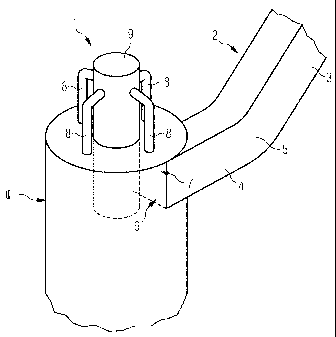Some of the information on this Web page has been provided by external sources. The Government of Canada is not responsible for the accuracy, reliability or currency of the information supplied by external sources. Users wishing to rely upon this information should consult directly with the source of the information. Content provided by external sources is not subject to official languages, privacy and accessibility requirements.
Any discrepancies in the text and image of the Claims and Abstract are due to differing posting times. Text of the Claims and Abstract are posted:
| (12) Patent: | (11) CA 2678398 |
|---|---|
| (54) English Title: | CYCLONE WITH CLASSIFIER INLET AND SMALL PARTICLE BY-PASS |
| (54) French Title: | CYCLONE COMPORTANT UNE ENTREE DE CLASSIFICATEUR ET UNE DERIVATION DE PARTICULES FINES |
| Status: | Expired and beyond the Period of Reversal |
| (51) International Patent Classification (IPC): |
|
|---|---|
| (72) Inventors : |
|
| (73) Owners : |
|
| (71) Applicants : |
|
| (74) Agent: | SMART & BIGGAR LP |
| (74) Associate agent: | |
| (45) Issued: | 2011-05-31 |
| (86) PCT Filing Date: | 2008-02-13 |
| (87) Open to Public Inspection: | 2008-08-21 |
| Examination requested: | 2009-08-14 |
| Availability of licence: | N/A |
| Dedicated to the Public: | N/A |
| (25) Language of filing: | English |
| Patent Cooperation Treaty (PCT): | Yes |
|---|---|
| (86) PCT Filing Number: | PCT/GB2008/050093 |
| (87) International Publication Number: | WO 2008099214 |
| (85) National Entry: | 2009-08-14 |
| (30) Application Priority Data: | ||||||
|---|---|---|---|---|---|---|
|
A cyclone is provided which combines a classi fier inlet, which provides at least partial separation of particles according to size, with a by-pass arrangement which diverts selected particles to a cyclone discharge duct. The invention has particular utility in the collection of particles from blast furnace waste gasses.
L'invention concerne un cyclone qui combine une entrée de classificateur permettant de séparer au moins partiellement des particules selon leur taille, avec un dispositif de dérivation qui détourne des particules sélectionnées vers un conduit de décharge de cyclone. L'invention est particulièrement utile dans la collecte de particules provenant de gaz d'échappement de hauts fourneaux.
Note: Claims are shown in the official language in which they were submitted.
Note: Descriptions are shown in the official language in which they were submitted.

2024-08-01:As part of the Next Generation Patents (NGP) transition, the Canadian Patents Database (CPD) now contains a more detailed Event History, which replicates the Event Log of our new back-office solution.
Please note that "Inactive:" events refers to events no longer in use in our new back-office solution.
For a clearer understanding of the status of the application/patent presented on this page, the site Disclaimer , as well as the definitions for Patent , Event History , Maintenance Fee and Payment History should be consulted.
| Description | Date |
|---|---|
| Time Limit for Reversal Expired | 2015-02-13 |
| Letter Sent | 2014-02-13 |
| Inactive: Office letter | 2013-07-17 |
| Letter Sent | 2013-07-17 |
| Grant by Issuance | 2011-05-31 |
| Inactive: Cover page published | 2011-05-30 |
| Inactive: Final fee received | 2011-03-16 |
| Pre-grant | 2011-03-16 |
| Letter Sent | 2011-02-28 |
| Notice of Allowance is Issued | 2011-02-28 |
| Notice of Allowance is Issued | 2011-02-28 |
| Inactive: Approved for allowance (AFA) | 2011-02-21 |
| Amendment Received - Voluntary Amendment | 2011-01-21 |
| Inactive: S.30(2) Rules - Examiner requisition | 2010-11-29 |
| Inactive: Office letter | 2010-02-23 |
| Appointment of Agent Requirements Determined Compliant | 2010-02-23 |
| Revocation of Agent Requirements Determined Compliant | 2010-02-23 |
| Inactive: Office letter | 2010-02-23 |
| Revocation of Agent Request | 2010-02-12 |
| Revocation of Agent Request | 2010-02-12 |
| Appointment of Agent Request | 2010-02-12 |
| Appointment of Agent Request | 2010-02-12 |
| Inactive: Cover page published | 2009-11-09 |
| Letter Sent | 2009-10-15 |
| Inactive: Acknowledgment of national entry - RFE | 2009-10-15 |
| Inactive: First IPC assigned | 2009-10-13 |
| Application Received - PCT | 2009-10-13 |
| National Entry Requirements Determined Compliant | 2009-08-14 |
| Request for Examination Requirements Determined Compliant | 2009-08-14 |
| All Requirements for Examination Determined Compliant | 2009-08-14 |
| Application Published (Open to Public Inspection) | 2008-08-21 |
There is no abandonment history.
The last payment was received on 2011-01-19
Note : If the full payment has not been received on or before the date indicated, a further fee may be required which may be one of the following
Please refer to the CIPO Patent Fees web page to see all current fee amounts.
| Fee Type | Anniversary Year | Due Date | Paid Date |
|---|---|---|---|
| Request for examination - standard | 2009-08-14 | ||
| Basic national fee - standard | 2009-08-14 | ||
| MF (application, 2nd anniv.) - standard | 02 | 2010-02-15 | 2010-01-08 |
| MF (application, 3rd anniv.) - standard | 03 | 2011-02-14 | 2011-01-19 |
| Final fee - standard | 2011-03-16 | ||
| MF (patent, 4th anniv.) - standard | 2012-02-13 | 2012-01-10 | |
| MF (patent, 5th anniv.) - standard | 2013-02-13 | 2013-01-17 | |
| Registration of a document | 2013-07-02 |
Note: Records showing the ownership history in alphabetical order.
| Current Owners on Record |
|---|
| SIEMENS PLC |
| Past Owners on Record |
|---|
| PETER EVANS |
| WILLIAM BARRY FEATHERSTONE |